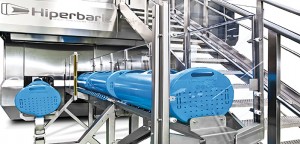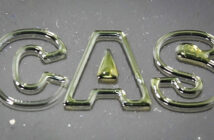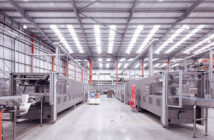
It was 1898 when B H Hite, a chemist from West Virginia, introduced milk in a manual press
It was 1898 when B H Hite, a chemist from West Virginia, introduced milk in a manual press he had made for achieving high hydrostatic pressures; he realised that milk lasted longer after doing so. Pressure has killed the spoilage bugs, he thought and he was right.
Almost at the same time and following Becquerel’s discovery of radioactivity in 1895, first research on the use of ionising energy to destroy microbes in food was published in a German medical journal. In the late 1940s, B L Flaumenbaum observed in his lab in Germany that fruit subjected to quick pulsed electricity saw their permeability increased, and microbes were inactivated.
Over a century after these initial discoveries and thanks to the evolution of designs and materials, we are seeing that these old solutions have, finally, become available to the food industry in a profitable way. The first method is now known as High Pressure Processing (HPP); the third, as Pulsed Electric Fields (PEF); the second, food irradiation, had an earlier adoption (it was firstly approved in the United States in 1986 and irradiated foods started to be commercialised in the 1990s).
In the last few years other technological advances have appeared in the food manufacturing space. With ultrasound, food manufacturers can take advantage of the cavitation generated by sound waves passing through the food and breaking the cell membranes of bacteria. Cold plasma, the most recent development in the sector, is still in the experimental phase. Plasma, aka the ‘fourth state’ of matter, is obtained applying extremely high energies to a gas, creating a gliding arc of ionised, nonthermal plasma that is able to sterilise the surface of foods.
These new techniques fit well in schemes pursued by food manufacturers, such as the hurdle concept and the minimal processing scheme which, respectively, promise food safety through putting barriers to the presence and growth of bugs along the food processing chain, and nutrition, functionality and retention of freshness in case of the latter minimal, gentle processing. Something else is shared by irradiation, high pressure processing, pulsed electric fields, or plasma treatment: they are all nonthermal technologies, meaning they don’t involve heating. These processes are applied to the food usually in chilled or ambient temperature condition so the components can stay fresh.
Heating the food is the traditional way of preserving foodstuffs and getting rid of undesirable spoilage microorganisms and pathogens. It is a great and effective way for obtaining safe products that last longer in our fridge or on the shelves. But it tends to flatten flavours and colours, and to harm the functionality and nutrition of the fresh, destroying for example vitamins or antioxidants. Additives and preservatives are the second common tool for making foods stable and safer, but consumers don’t want to see them on the labels. Overall, consumer demand is generating the need for new processing solutions and meals that are fresher, more natural, minimally processed, and with no artificial ingredients. These are precisely the most complicated to handle in the factory from the perspective of food safety and preservation, and this is why new hurdles and solutions are being implemented.
HPP systems are probably the highest growth category, with foods worth more than 750,000 Tons of product being processed annually, according to Hiperbaric, S.A., Burgos, Spain, a leading manufacturer of these industrial installations. The technique basically consists in applying pressures around 6,000 bar (6,000 atmospheres or 87,000 psi) to food during three to five minutes. Imagine submerging your bottle of fresh juice or your luncheon meat in the bottom of an ocean that was 60Km deep – 6 times more than the depth of the Mariana Trench, and that’s what high pressure processing is about. The microbes are destroyed but the food stays intact because pressure is isostatic, transmitted by water, and then equal from all sides.
HPP has seen spectacular growth over the past decade, and is projected to become one of the key factors of the new food industry and the most promising emerging technique, according to a Campden BRI (UK) study published in the journal Innovative Food Science and Emerging Technologies this year.
According to Hiperbaric, Cold Pressure Tecnology or HPP (High Pressure Processing) is becoming more mainstream in certain food spaces outside the traditional ones (mainly guacamole, continental meats, lobsters, to name a few), and two particular segments are now driving its growth: cold pressed juices, and HPP Tolling.
In the past three years, the cold pressed juice category has experienced explosive growth with well known names such as Suja, Evolution Fresh, Blueprint, Coldpress, Harmless Harvest etc. All of them are Hiperbaric customers. The Spanish company is growing this year to a turnover of more than 70m and has an order backlog for 2016 that indicates it might surpass 100m in 2016.
The second segment in which HPP technology is becoming more widely implemented is the Tolling/Copacking business model, in which contract service companies, refrigerated service suppliers and logistic platforms are adding Hiperbaric lines as a way to add value to their services. Using the network of toll HPP services, any food maker with a need for a pathogen lethality intervention, a extension of the product shelf life, or access to export markets, can access high pressure technology and pay on a per Kg, per pack or per batch basis, without the need of investing in its own Hiperbaric system.
In Australia and New Zealand, currently a total of 14 HPP systems are operating in most of the different segments including meat, shellfish, juices, nut milk, guacamole, RTE meals etc.
From laboratory to final industrial practice, gentle physical processes are helping the food industry in the making of hopefully safer, better eats and displacing chemicals from our diets. If evolution continues as expected and the price of these systems is progressively brought down, we will increasingly see pressurised meals and cold plasma hygienised dinners on our table.
For more information contact:
Scanz Technologies Ltd.
Phone: 09 520 2544




























































































